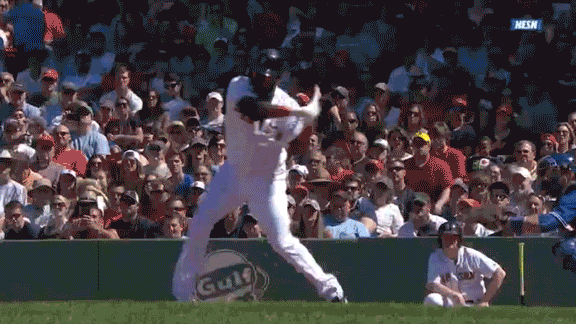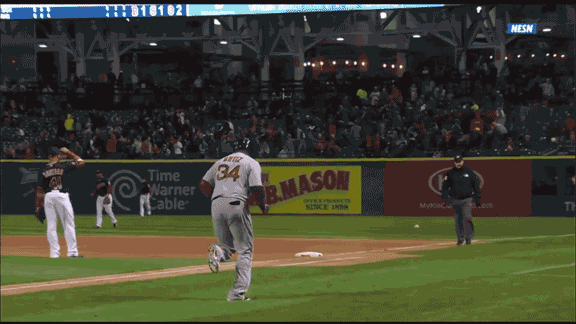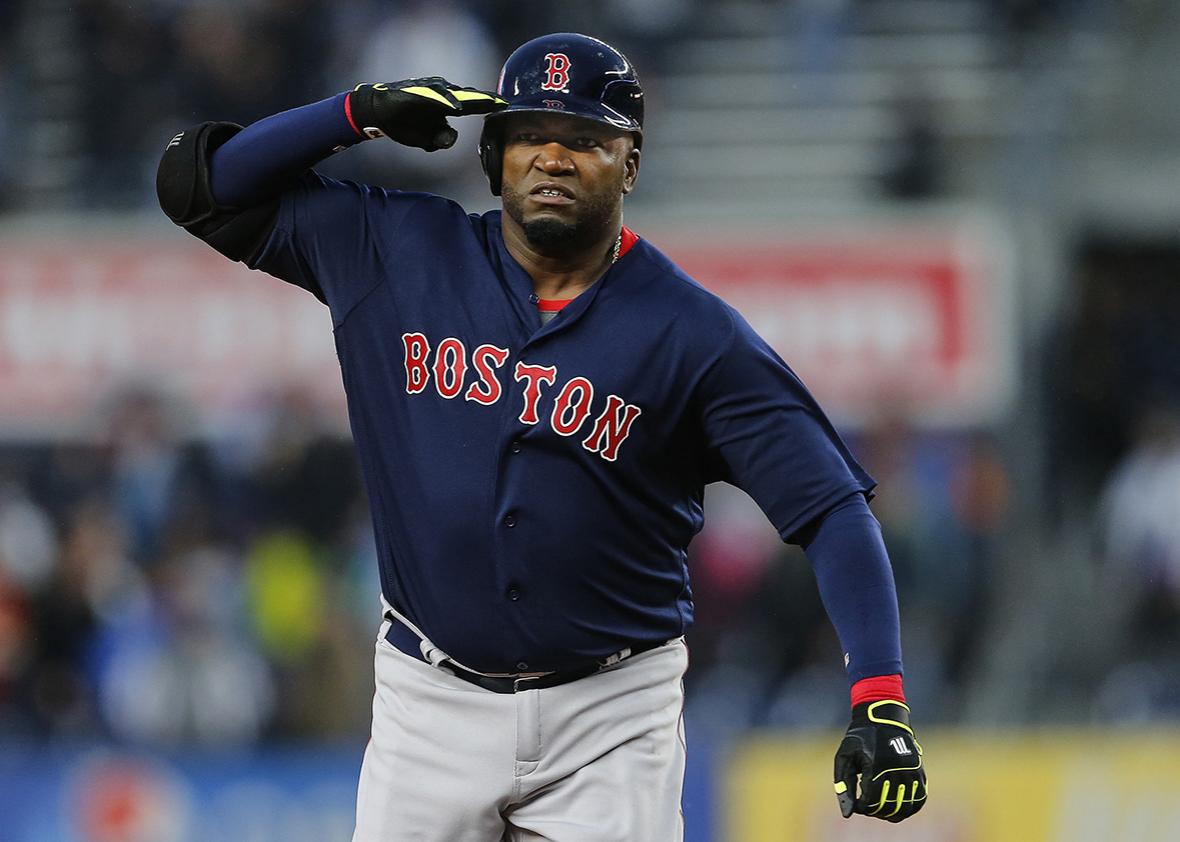A lot is going to be written about David Ortiz this year, as the Boston Red Sox hero completes his retirement tour. There will be articles and videos devoted to his impact on the Red Sox franchise, his connection with fans, and his work with kids in Boston and the Dominican Republic. A future Hall of Famer like Big Papi is worthy of every one of these tributes, but there’s one more that I want to make sure gets written.
As the proprietor of the Tater Trot Tracker, a website devoted to measuring how long it takes major league ballplayers to circle the bases after each home run, I have studied more than 19,000 home run trots since the start of the 2010 season. In the last six-plus seasons, I’ve watched enough trots to cover the 1,300-mile distance between Chicago and Miami, 360 feet at a time. In other words, I know a thing or two about circling the bases, and all these years of diligent study have left me convinced of one incontrovertible fact: David Ortiz is the greatest home run trotter in the modern game, and perhaps in the history of baseball.
For the typical home run hitter, the trot is simply a means to an end: The ball cleared the fence, and you need to touch all four bases for the run to count. In the video below, Christian Yelich breaks up a late-inning no-hitter at Yankee Stadium and jogs home in 21.9 seconds, the precise average time for a major leaguer. It’s a boring and utilitarian trot.
In big moments, or when a player with a big personality hits one out, some emotion does come through. A big smile, a congratulatory hand slap, even a lost helmet—we see some variation of this almost every day, and as fans we eat these moments up. Yasiel Puig is a great example of an excitable trotter—note how he starts his jaunt with a flip of the bat.
But even Puig can’t keep it going after every blast. While splashy trots are commonplace across the league as a whole, not many players have it in them to be splashy every time out.
These consistently atypical trotters—the ones who break convention—are the ones we remember most. They show us what a home run trot can be at the extremes. At one end of the trot continuum are the speedsters. Bryce Harper, Carlos Gomez, Andrew McCutchen, and others have all had their moments as speedy trotters, but age and/or indifference always slows them down. Only San Diego’s Adam Rosales, who had three trots quicker than 16 seconds back in 2010 and still owns nine of the 13 fastest trots I’ve ever recorded, has any kind of argument to unseat Ortiz as King of the Home Run Trots. Just look at this guy go.
The problem with the speedy trot is that it just doesn’t happen often enough. A Rosales trot is always worth watching, but since he’s not a home run hitter, we only get to see it two or three times a year. A Billy Hamilton scamper, too, is always great fun, but the Reds outfielder has only hit three home runs so far this year and has never hit more than six in a season.
Slow trots are far easier to achieve and as such have a higher bar to clear before becoming memorable. To become immortal, a slow trotter can’t just be a large man moving at a glacial pace. A slow trot achieved under the right conditions is something different, something special. It’s a fine line that David Ortiz straddles during every trip around the bases.
What makes Ortiz a home run–trotting legend? How could he possibly have such a slow trot every single time? This trot from May 30—which, at 30.76 seconds, happens to be one of Big Papi’s slowest trots ever—is a great example of how Ortiz makes the magic happen.
There are three key moments that make every Ortiz trot so reliably slow.
At the plate: Papi poses for a moment after each big blast, arms wide, chest open. Is he savoring the moment or merely following through with good form? Chances are it’s a bit of both. This homer from 2015—the 475th of his career—is a great example of his post-swing style.

MLB
Rounding first and third: As he approaches first, Ortiz veers off into the grass for a wide turn. While this is common for all ballplayers, few turn as wide as Ortiz. See this trot from October 2015.

MLB
What isn’t quite so common is the wide turn he makes at third base. Instead of cutting in toward the corner of the bag, Ortiz goes to the outfield side of the hot corner, as if he wants to stay on the infield dirt as long as possible. This gives Ortiz a straight shot to home along the baseline, but it lengthens his trot.
Touching home: For most ballplayers, the third base line is a standard 90 feet. They round third and run home, maybe slowing down slightly at the plate to high five some teammates or make the proper turn back to the dugout. For David Ortiz, the third base line is maybe 85 feet long. It ends somewhere between the start of the home plate circle and the batter’s box. At that point, Papi stops running and takes the three most deliberate steps in baseball: a right foot into the batter’s box, followed by a left foot on the plate, and then a final step to bring the two feet together on the plate. Meanwhile, he brings both hands to his lips, looks towards the sky, and sends a kiss to the heavens. Watch and marvel at how Ortiz approached the plate after hitting his milestone 500th career home run.

MLB
The trot is over, but that final approach to the plate easily adds 1 or 2 seconds to his trot time. Factor in the additional second or two he took at the plate with the smooth follow through, plus the extra time he took with wide turns at both first and third, and you understand why Ortiz has the longest average trot time in baseball: nearly 28 seconds.
The speed or lack thereof isn’t what makes David Ortiz the best home run trotter in baseball. It’s the consistency and personality. His trot (and the magnetic smile that often accompanies it) betrays the feeling that so many ballplayers try to hide—that, 500-plus home runs later, he still gets a kick out of hitting the ball really, really far. In an interview earlier this year, Ortiz told Esquire, “People always want to criticize players like myself, like Bryce Harper, a lot of players around the league who, when we hit a homer, we enjoy it or whatever. We’re not trying to embarrass anybody. … We have fun, people enjoy watching what we do.”
Having spent a not insignificant portion of my life watching players celebrate home runs, I agree with Big Papi. A home run trot is fun for fans, and it should be fun for players. A Papi trot shows us that at least some players enjoy playing the game as much as we enjoy watching it. It shows us that the fun in the ballpark extends beyond the stands and onto the field. It shows us that, if we had somehow managed to achieve our dreams of being a major leaguer, we would still love the game as much as we did when we were kids.
David Ortiz can take all the time circling the bases he wants. As he winds up his career, he only has so many more chances to blow those kisses to the sky, and we only have so many more times to watch him. Might as well make those trots last as long as possible.
